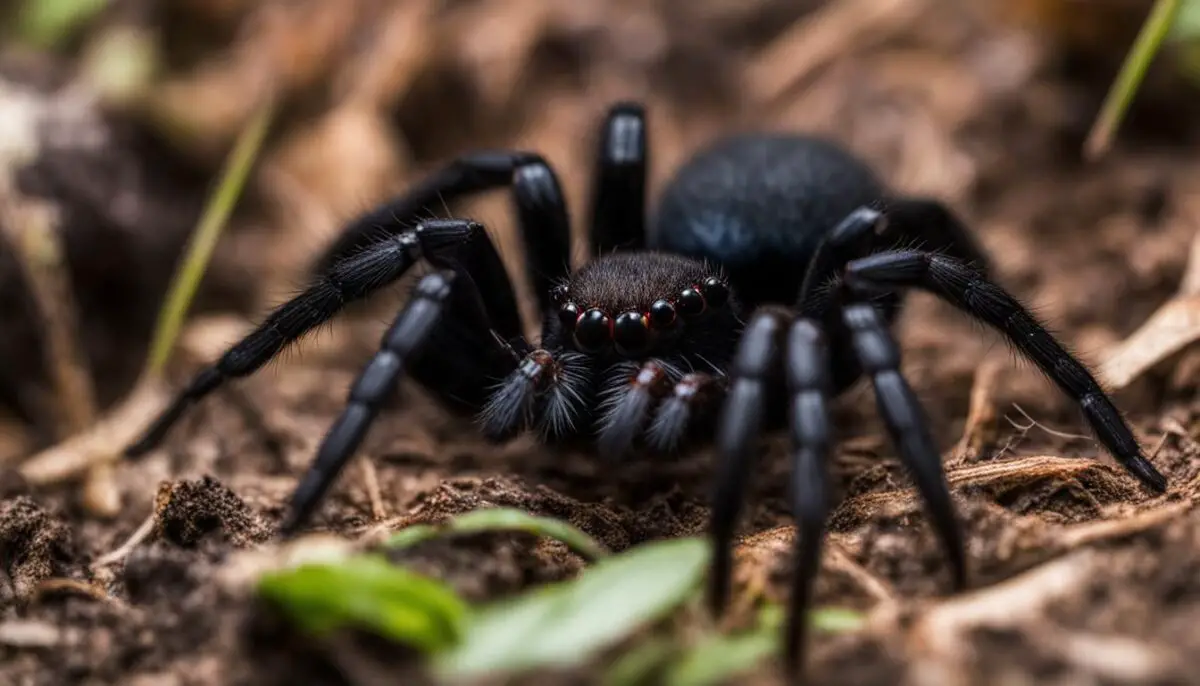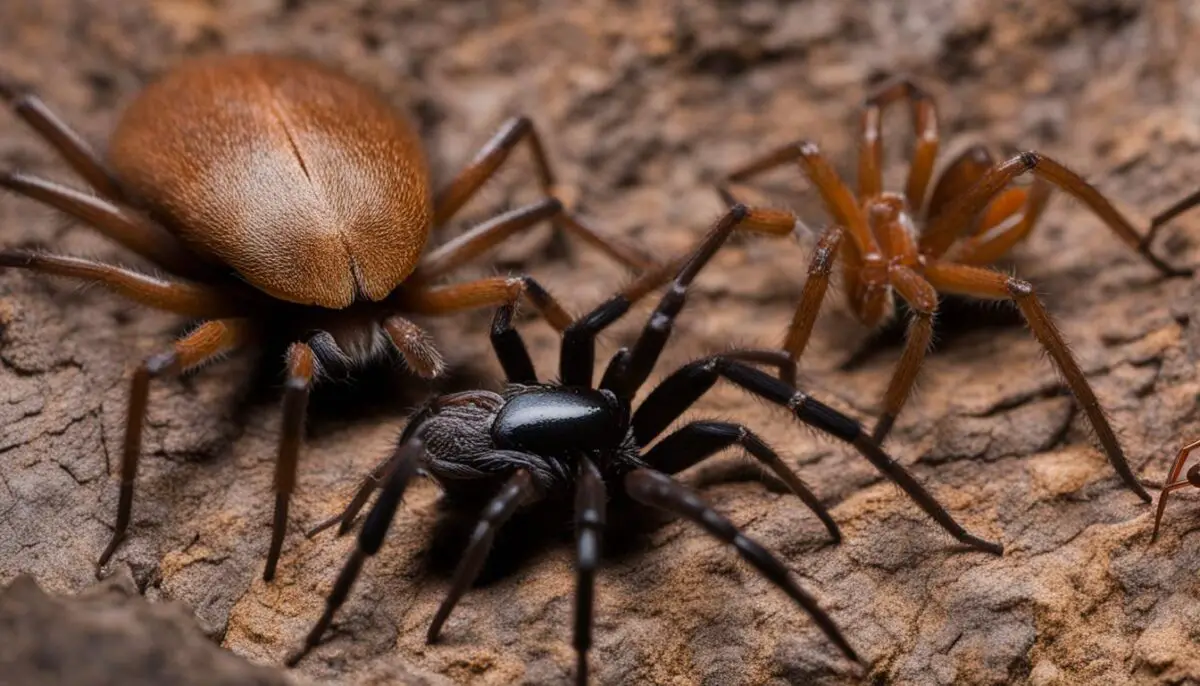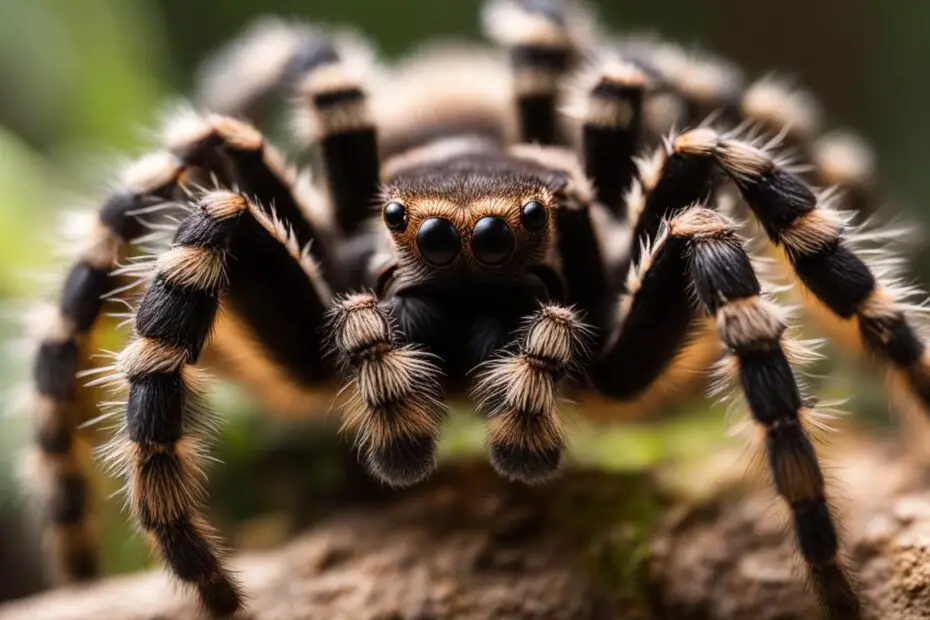When it comes to tarantulas, there is often a misconception that all of them are poisonous and pose a danger to humans. However, this is far from the truth. In fact, there are several tarantula species that are completely non-poisonous and safe to handle.
One such safe tarantula species is the trapdoor spider, specifically the Ummidia audouini. While trapdoor spiders, like most spiders, are venomous, their bites are generally not considered dangerous to humans. The venom of Ummidia audouini causes minimal concern, resulting in slight itchiness or irritation at most. It is important to educate yourself about specific tarantula species to understand the level of risk involved.
So, if you’re fascinated by tarantulas but concerned about their toxicity, rest assured that there are non-poisonous tarantulas like the Ummidia audouini that you can admire without worry.
Key Takeaways:
- Not all tarantulas are poisonous, there are non-poisonous tarantula species like the Ummidia audouini.
- Trapdoor spiders, including the Ummidia audouini, are venomous but generally pose no significant threat to humans.
- Understanding tarantula species and their venom toxicity can help alleviate fears and ensure safety when handling them.
- The Ummidia audouini is a safe tarantula species that can be admired without worry.
- Education about tarantula species is important to understand the level of risk involved.
What Tarantulas Are Not Poisonous
Are Trapdoor Spiders Poisonous?
When it comes to trapdoor spiders, one question that often arises is whether they are poisonous or not. The answer is, yes, trapdoor spiders are indeed venomous. Their venom is composed of various proteins and peptides that specifically target the nervous system of their prey. However, it’s important to note that the potency of their venom varies among different species.
The effects of a trapdoor spider bite on humans are generally not considered dangerous. While the venom can cause pain, swelling, redness, and itching, these symptoms are usually mild and subside over time. It’s worth mentioning that allergic reactions can occur in rare cases, which may require medical attention. If you happen to experience significant pain or adverse reactions after a spider bite, it is always advisable to seek medical assistance. what tarantulas are not poisonous
Trapdoor spiders, including the species Ummidia audouini, are fascinating creatures with unique adaptations. While their venom may not pose a significant threat to humans, it is essential to exercise caution and respect their habitats to ensure the safety of both humans and these remarkable arachnids.
Effects of Trapdoor Spider Venom on Humans
As mentioned earlier, the effects of trapdoor spider venom on humans are generally mild and temporary. The venom typically causes localized pain, swelling, redness, and itching at the site of the bite. These symptoms can last anywhere from a few hours to a couple of days, depending on the individual’s immune response and the specific species of trapdoor spider.
In rare cases, individuals may experience allergic reactions to trapdoor spider venom. These allergic reactions can range from mild skin irritation to more severe symptoms, such as difficulty breathing or anaphylaxis. If you have a known allergy to spider venom or experience any severe or concerning symptoms after a bite, seek immediate medical attention. tarantulas with no venom
Comparing Trapdoor Spiders and Other Venomous Spiders
When comparing trapdoor spiders to other venomous spiders, such as the black widow or brown recluse, there are notable differences in venom potency and effects on humans. Unlike trapdoor spiders, which have venom that is generally not considered medically significant, venomous spiders like the black widow and brown recluse possess venom that can cause severe health complications in humans. harmless tarantula species
Table: Comparison of Trapdoor Spiders and Venomous Spiders
| Aspect | Trapdoor Spiders | Venomous Spiders (Black Widow and Brown Recluse) |
|---|---|---|
| Size | Medium to large | Small to medium |
| Color | Brown or black | Black (black widow) or brown (brown recluse) |
| Venom Potency | Generally not significant | Medically significant |
| Distribution | Eastern and southwestern U.S. | Widespread in the U.S. |
As shown in the table, trapdoor spiders differ from venomous spiders in terms of size, color, venom potency, and distribution. It’s important to be able to identify and differentiate these species to ensure appropriate precautions are taken in specific geographical areas. non-toxic tarantulas
Trapdoor Spiders Overview
Trapdoor spiders belong to the family Ctenizidae and are primarily found in the United States, particularly in the eastern and southwestern regions. The most speciose genus is Ummidia, comprising about 50 species. Trapdoor spiders are medium to large in size and are typically brown or black in color. non-lethal tarantula breeds
They have modified front legs for digging burrows and construct silk-lined burrows with hinged trapdoors. Trapdoor spiders are primarily ambush predators and feed on insects and other small invertebrates. Their burrows serve as their hunting grounds, where they patiently wait for prey to pass by before swiftly capturing them.
With their unique adaptations and physical characteristics, trapdoor spiders have mastered the art of survival. Their strong burrow construction and hinged trapdoor protect them from predators while providing a secure environment for hunting. Their excellent reflexes and camouflage help them capture prey and avoid danger. trapdoor spiders play an essential role in maintaining ecological balance by controlling populations of harmful insects and contributing to pest control efforts.

Trapdoor Spiders Physical Characteristics:
- Size: Medium to large
- Color: Brown or black
- Front legs: Modified for digging burrows
- Burrow: Silk-lined with a hinged trapdoor
Trapdoor Spiders Distribution:
Trapdoor spiders are primarily found in the United States, particularly in the eastern and southwestern regions. They inhabit various states such as California, New Mexico, Texas, and Florida.
Comparison: Trapdoor Spiders vs. Venomous Spiders
When it comes to comparing trapdoor spiders and venomous spiders, there are some notable differences to consider. Let’s take a closer look at these two types of spiders and explore their distinct characteristics.
Size and Appearance
Trapdoor spiders are typically medium to large in size, ranging from around 0.5 to 2 inches in length. They are known for their brown or black coloration, which helps them blend in with their natural surroundings. In contrast, venomous spiders like the black widow and brown recluse are smaller in size, with lengths ranging from 0.25 to 1 inch. They are usually black (black widow) or brown (brown recluse) in color.
Venom and Danger
One of the key differences between trapdoor spiders and venomous spiders lies in their venom composition and potency. Trapdoor spiders possess venom that is generally not considered significant or dangerous to humans. While their bites may cause pain, swelling, and itching, the effects are usually mild and resolve on their own. On the other hand, venomous spiders like the black widow and brown recluse have medically significant venom that can cause more severe symptoms and complications in humans if bitten.
Habitat and Distribution
Trapdoor spiders are primarily found in the eastern and southwestern regions of the United States, where they construct silk-lined burrows with hinged trapdoors. These spiders prefer to live in underground habitats and are often encountered in wooded areas. In contrast, venomous spiders such as the black widow and brown recluse have a wider distribution and can be found in various environments both indoors and outdoors.
| Trapdoor Spiders | Venomous Spiders |
|---|---|
| Medium to large in size | Small to medium in size |
| Brown or black coloration | Black (black widow) or brown (brown recluse) coloration |
| Venom is generally not significant | Medically significant venom |
| Primarily found in eastern and southwestern U.S. | Widespread distribution in the U.S. |
As seen in the comparison table, trapdoor spiders and venomous spiders have distinct characteristics that set them apart. Understanding these differences can help us better appreciate the unique nature of each spider species and make informed decisions when encountering them in their natural habitats.
Behavior and Habitat
Trapdoor spiders have fascinating behavior and unique adaptations that help them thrive in their natural habitats. Let’s explore their feeding habits, hunting techniques, and some of their remarkable adaptations.
Feeding Habits
Trapdoor spiders are ambush predators that primarily feed on insects and other small invertebrates. They use their silk-lined burrows as hunting grounds, patiently waiting for unsuspecting prey to pass by. Once a potential meal is within reach, the spider quickly captures it with its strong front legs. The prey is then subdued with a bite from its venomous fangs. This feeding strategy allows trapdoor spiders to efficiently secure their meals while minimizing their own exposure to danger.
Unique Adaptations
Trapdoor spiders possess several unique adaptations that enable them to thrive in their specific habitats. One of their most notable adaptations is their ability to construct silk-lined burrows with hinged trapdoors. These burrows not only provide protection from predators but also serve as an effective hunting mechanism. The trapdoor acts as a camouflage, blending seamlessly with the surrounding environment, making it difficult for potential prey to detect the spider’s presence.
Additionally, trapdoor spiders have excellent reflexes, allowing them to swiftly capture prey and retreat into their burrows to avoid danger. Their front and middle legs are modified for digging and constructing intricate burrows, ensuring they have a safe and secure place to reside. These adaptations have helped trapdoor spiders survive and thrive in various habitats, ranging from forests and grasslands to deserts and wetlands.

Summary
Trapdoor spiders exhibit fascinating behavior and have unique adaptations that allow them to be effective ambush predators. Their feeding habits revolve around patiently waiting for prey near their silk-lined burrows and using their venomous fangs to subdue their victims. Their adaptations, such as well-structured burrows with hinged trapdoors and excellent reflexes, help them blend into their surroundings and ensure their safety. Overall, these remarkable creatures have evolved to be well-suited for their specific habitats and play a vital role in maintaining the balance of ecosystems.
Trapdoor Spiders vs. Brown Recluse Spiders
When it comes to distinguishing between trapdoor spiders and brown recluse spiders, several key differences set them apart. Understanding these contrasts is essential for accurately identifying these arachnids and recognizing any potential risks they may pose. Let’s take a closer look at the characteristics and behaviors that differentiate these two spider species.
Differences in Appearance
One noticeable distinction between trapdoor spiders and brown recluse spiders lies in their size. Trapdoor spiders are usually medium to large, while brown recluse spiders are comparatively smaller, ranging from 1/2″ to 1 1/2″ long. In terms of color, trapdoor spiders are typically brown or black, blending in with their underground burrow habitats. Brown recluse spiders, on the other hand, are generally light to dark brown, often with a distinctive violin-shaped marking on their backs.
Habitat and Behavior Contrasts
Trapdoor spiders are primarily found in underground burrows, where they spend most of their time waiting for prey to pass by. Brown recluse spiders, on the contrary, can be found both indoors and outdoors, preferring dark and secluded areas such as basements, closets, and woodpiles. While trapdoor spiders are typically non-aggressive and avoid human contact, brown recluse spiders may bite if they feel threatened or cornered, potentially causing severe symptoms that require medical attention.
Divergent Venomous Effects
One critical disparity between trapdoor spiders and brown recluse spiders is the venomous impact they have on humans. Trapdoor spider bites are generally considered non-dangerous, causing only mild reactions such as pain, redness, swelling, and itchiness. In contrast, brown recluse spider bites can lead to more severe symptoms, including necrotic skin lesions that may require medical treatment. It is important to seek immediate medical attention if you suspect you have been bitten by a brown recluse spider or experience an adverse reaction.

| Comparison | Trapdoor Spiders | Brown Recluse Spiders |
|---|---|---|
| Size | Medium to large | Smaller (1/2″ to 1 1/2″ long) |
| Color | Brown or black | Light to dark brown, often with a violin-shaped marking |
| Habitat | Underground burrows | Indoors and outdoors, dark and secluded areas |
| Behavior | Non-aggressive, avoid human contact | May bite if threatened or cornered |
| Venomous Effects | Mild reactions (pain, redness, swelling, itchiness) | Severe symptoms (necrotic skin lesions) |
Conservation and Human Impact
The conservation of trapdoor spiders is crucial to ensuring the long-term survival of these fascinating creatures. Despite their important ecological roles and beneficial contributions to pest control, trapdoor spiders face various threats that need to be addressed.
Habitat loss is one of the primary concerns for trapdoor spiders. The destruction and alteration of their natural habitats, often due to urbanization and agriculture, significantly reduce their available living spaces. This loss of habitat not only directly affects the spider populations but also disrupts the delicate balance of local ecosystems.

Another significant threat to trapdoor spiders is pesticide exposure. The use of chemical pesticides in agricultural practices and residential areas can have detrimental effects on spider populations. Pesticides not only directly harm spiders but can also impact their prey, disrupting the spider’s food source and overall ecosystem stability.
Despite these challenges, conservation efforts are underway to protect trapdoor spiders and their habitats. These efforts include the preservation and restoration of natural habitats, promoting sustainable land management practices, and educating the public about the importance of spiders in maintaining ecosystem health. By increasing awareness and understanding, we can foster a greater appreciation for these remarkable creatures and take steps towards their conservation.
| Threats to Trapdoor Spiders | Conservation Efforts |
|---|---|
| Habitat loss due to urbanization and agriculture | Preservation and restoration of natural habitats |
| Pesticide exposure | Promotion of sustainable land management practices |
| Educating the public about the importance of spiders in ecosystems |
Conclusion
In conclusion, it is important to note that not all tarantulas are poisonous. While trapdoor spiders, including the Ummidia audouini species, are venomous, their bites generally pose little threat to humans. Understanding the specific tarantula species and their venom toxicity can help alleviate fears and ensure safety when encountering these fascinating creatures.
It is worth noting that there are non-toxic tarantula species that can be considered harmless. These tarantulas possess venom that is of minimal concern to humans, causing only slight itchiness or irritation. Therefore, it is crucial to educate yourself about the different tarantula species to understand the level of risk involved.
Furthermore, trapdoor spiders, including the Ummidia audouini, contribute to pest control efforts and play an important role in maintaining the balance of ecosystems. By feeding on insects, they help reduce the number of pests harmful to crops and also assist in controlling disease-carrying insects.
FAQ
Are trapdoor spiders dangerous to humans?
Trapdoor spiders, including Ummidia audouini, are generally not considered dangerous to humans. While they are venomous, their venom is of minimal concern and typically causes slight itchiness or irritation.
What should I do if I get bitten by a trapdoor spider?
If you experience significant pain or adverse reactions after a trapdoor spider bite, it is important to seek medical attention. While their bites are generally not dangerous, it’s always best to have a healthcare professional assess your symptoms.
Where are trapdoor spiders found?
Trapdoor spiders, particularly Ummidia audouini, are primarily found in the United States, specifically in the eastern and southwestern regions.
How do trapdoor spiders capture their prey?
Trapdoor spiders use their silk-lined burrows as hunting grounds. They wait for their prey to pass by, then quickly capture them using their excellent reflexes.
How do trapdoor spiders differ from venomous spiders like the black widow and brown recluse?
Trapdoor spiders are generally medium to large in size, while venomous spiders like the black widow and brown recluse are smaller. Additionally, trapdoor spiders are brown or black in color, while venomous spiders are black or brown. The venom of trapdoor spiders is generally not significant, while venomous spiders have medically significant venom.
What threats do trapdoor spiders face?
Trapdoor spiders, like many other species, face threats such as habitat loss and pesticide exposure. These factors can lead to population decline and have a negative impact on their survival.


That is really fascinating, You’re a very skilled blogger.
I’ve joined your feed and sit up for searching for extra of your great post.
Also, I’ve shared your website in my social networks
Hi, its nice paragraph about media print, we all be aware of media is a great source of facts.
I do like the manner in which you have presented this particular concern and it does indeed offer me some fodder for consideration. However, from just what I have witnessed, I simply wish when the actual opinions pack on that people today stay on issue and not start upon a soap box of the news du jour. Yet, thank you for this fantastic piece and while I can not necessarily agree with it in totality, I value the standpoint.
Post writing is also a fun, if you be familiar with afterward you can write otherwise it is complex to write.
Write more, thats all I have to say. Literally, it seems as though you relied
on the video to make your point. You clearly know what youre talking about,
why throw away your intelligence on just posting videos to your site when you could be giving us something informative to
read?
I like this website very much, Its a very nice position to read and incur info.Money from
blog